#CoffeeAndKlon is my (irregular!) Sunday morning magazine series, where I talk about whatever’s on my mind right now. There’s always coffee, and there’s normally chat about the Klon and its many competitors.
Back at the end of September, PRS announced that they were getting into the pedal business. There were three pedals launched, and amongst them was a drive pedal that they called ‘Horsemeat’ … because it’s a Klon-killer.
But is it really? Read on to find out what I think …
Table of Contents
- tl;dr
- Context
- I’ve Missed My Coffee
- If You’re New To The Blog, Welcome!
- My Signal Chain
- Let’s Hear The Damn Pedals!
- Where Does The Idea That The PRS Horsemeat Is A Klon-Killer Come From?
- What Does A Klon-Killer Need To Be Able To Do?
- The Horsemeat Is Not A Klon-Killer For Me …
- … But It’s A Killer Tweed-Tone Drive Pedal
- Which Is Your Favourite As The Primary Overdrive Pedal?
- What About As A Cranked Boost?
- What About As A Tone-Shaping Tool?
- Final Thoughts
tl;dr
I don’t think that the PRS Horsemeat is a Klon-killer, because it can’t replace my Klon KTR in the clean boost role. There are audio demos below for you to decide for yourself.
However, I think the Horsemeat is an absolutely cracking tweed-tone overdrive pedal (something it isn’t marketed to be), and it has joined my beloved Sweet Honey Overdrive pedal as my joint-#1 overdrive pedal.
Context
This blog post is based on a Mastodon thread that I posted on Sunday 27th November 2022. Sadly, it’s taken me a month to find the time to turn it into a blog post. I hope you still enjoy it.
I’ve Missed My Coffee
I’m back from a recent stint of working away, and I’ve got to say: I’ve really missed my coffee machine.
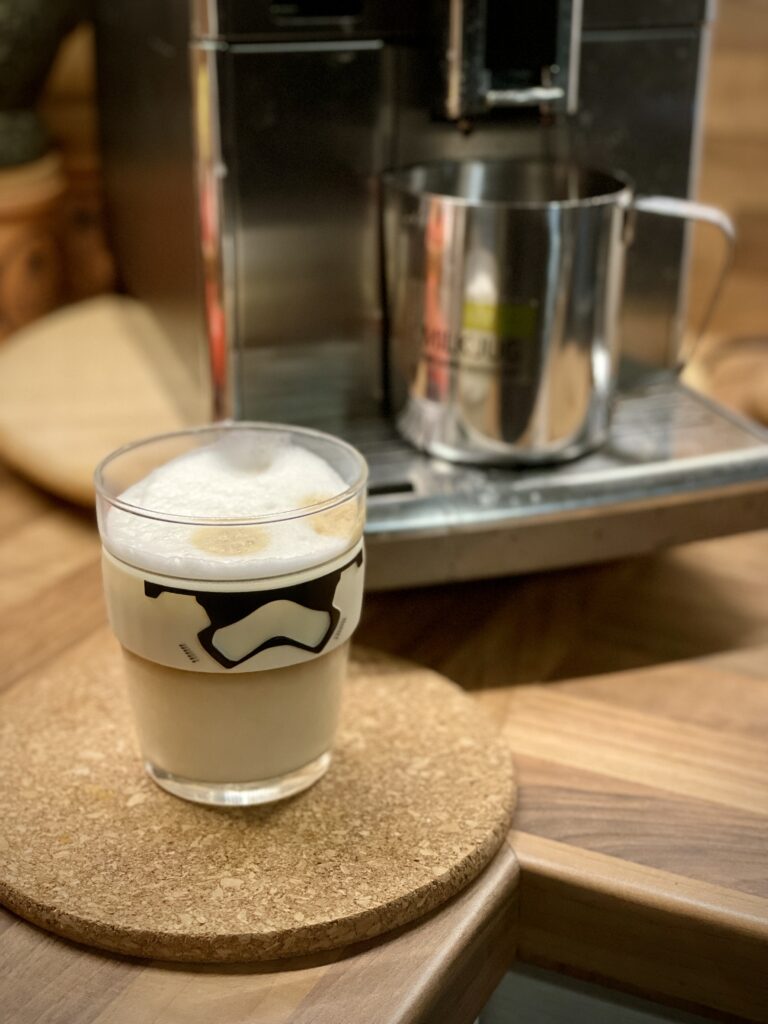
This morning, I’m finishing off the last of the Lavazza Gold that we have.
I normally prefer single-origin coffee, darkly roasted. It’s nice to mix it up, though, and to take a break from them at times.
I find most high-street coffee blends a bit sickly, if I’m honest, and I just can’t drink them at home. That’s one reason why I like the Lavazza Gold: I find it very drinkable. [I’m drafting this blog post a month later, on Boxing Day, and we’re back on the Lavazza Gold once again – Ed]
What’s your favourite coffee? Let me know in the comments below!
If You’re New To The Blog, Welcome!
There’s definitely some interest out there in how the PRS Horsemeat compares to a Klon, but not a lot of actual hands-on experience with both pedals at once. So if Google has sent you my way – welcome!
You can read all more about me in the About section of the blog, but basically: I’m a home hobbyist player. I play at home for my personal enjoyment and sanity. I’m not a professional musician. I don’t work in the music industry at all. I never have.
What I share here is just my personal experience as a home hobbyist.
I don’t claim any expertise or skill with this stuff at all. If you want great advice, ask an actual pro, not me 🙂
So why do I blog and post on social media about guitar gear?
- First off, because I’ve actually got access to the gear that I talk about.
Unfortunately, there’s a lot of folks out there (especially on the usual guitar-related forum and Facebook groups) who love to BS about gear that they don’t have – and sometimes have never even tried.
This whole blog started because friends would ask me questions about gear, and it just seemed easier to answer everyone once, in one place, than keep repeating myself on social media. - Secondly, sitting down to write about guitar gear forces me to really think about the gear, and to explore it with a bit more effort and (hopefully) a little less knee-jerk reaction.
This is how I learn about what my gear can do for me. I can’t promise that you’ll get the same results out of the same gear. Analogue gear is variable in nature, so all I can talk about is my experience with the individual unit that I have.
My Signal Chain
Here’s what I’m starting with on the board:
- Klon KTR
- PRS Horsemeat
- Mad Professor Sweet Honey Overdrive (SHOD for short)
All three pedals are in separate loops on my trusty Gigrig G2, so that they can’t interfere with the overall tone when they’re not in use.
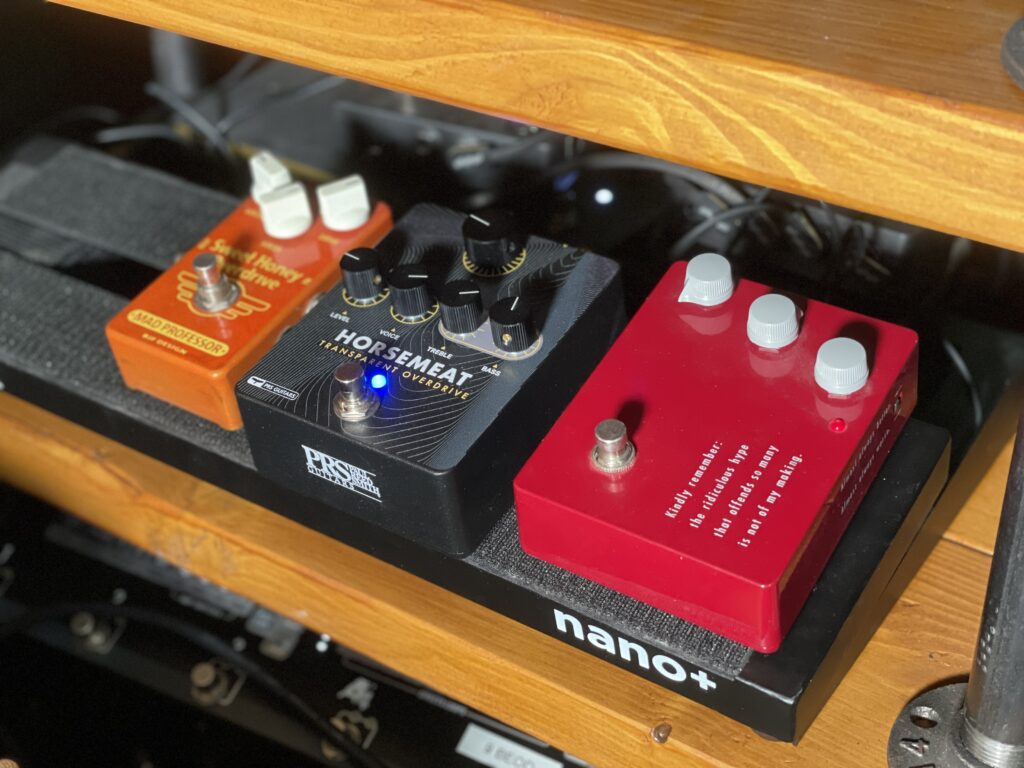
The pedals are running into my own patch on the Axe-FX 3, out to my Universal Audio Apollo unit, and into UAD’s LUNA DAW.
I’m only using LUNA for this because it’s great for low latency recording. I’ve got no plugins installed on any of the audio tracks; there’s no post-processing at all.
The audio demos that you’ll hear in this blog post were all recorded during the live Mastodon thread on Nov 27th 2022.
In the Axe-FX 3, I’m running:
- one amp (a Princeton model that I’ve tweaked the crap out of, to get me closer to the clean tone of my Marshall DSL20HR)
- two cabs (stock IRs that sound like the 1×12 cabs that I run my Marshall into, fitted with Celestion A-Type and Blue speakers)
- digital delay
- digital spring reverb
It’s basically my normal setup to emulate my favourite pedal platform value amp + FX loop home rig, just with the added convenience of sounding better and being much easier to record!
For guitar, I’m mostly going to use Smokey: my 2012 Gibson Les Paul Classic Plus. This model is the one with the baked maple fretboard, because the US Government had seized all of Gibson’s rosewood at the time.
It’s got a set of OX4 Hot Duane humbuckers, giving it a nice amount of punch and power. Plus, just look at these mineral streaks 😍
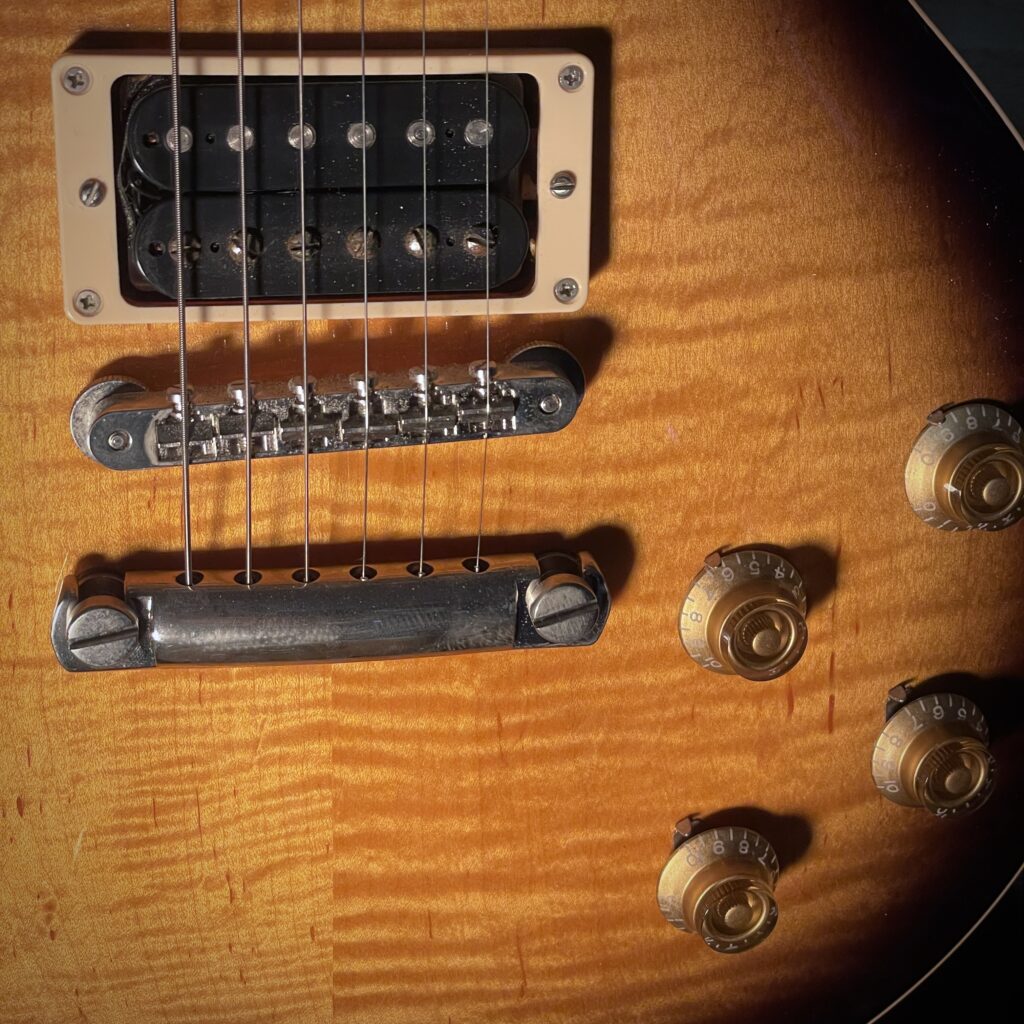
Let’s Hear The Damn Pedals!
To start with, I’m running the Klon KTR into my beloved Sweet Honey Overdrive (SHOD for short). The KTR is setup in the classic clean-boost role:
- Gain around 8 o’clock
- Treble at 1 o’clock
- Volume around unity or so
This is home for me. It’s not my desert island tone: it’s my last-day-on-earth tone. And this is what it sounds like:
For comparison, I’m going to take the Klon KTR out of the circuit, and record the same piece just using the SHOD on its own. And it sounds like this:
There’s a good reason why (as far as I know) the SHOD is the tweed-tone pedal that’s been in continuous production the longest. I love this pedal so much.
To my ears, it definitely sounds better when boosted by the Klon KTR though. Why, though?
On its own, the SHOD has a very soft attack, especially when I’m using the middle position of my Les Paul. The Klon adds definition and a little bit of bite to the attack, while pushing the mids to make the overall tone sound more forward.
Now that we have a baseline sound to compare against, let’s get to the main topic for this instalment of #CoffeeAndKlon: is the PRS Horsemeat the Klon-killer that it’s been marketed to be?
Where Does The Idea That The PRS Horsemeat Is A Klon-Killer Come From?
This idea comes direct from Paul Reed Smith himself:
https://youtube.com/clip/Ugkx8K3ZFGexUqfyHAE6lbwmCeX1kqx7R17f
(Sorry, the video clip won’t embed. But if you click though, you’ll see him telling the story of where the name comes from.)
Fair play to him: if he thinks he’s got a product that can take on the klone industry and win, I can understand why he wants to put that at the heart of how he’s selling the pedal.
What Does A Klon-Killer Need To Be Able To Do?
Hopefully, we can all agree on this: to be worthy of the label, a Klon-killer needs to push a Klon off the pedal board.
While Paul very clearly talks about the Klon Centaur, I think it’s reasonable to expand this to cover klones as well (as long as they’re not too different from a Klon). Only so many Klon Centaurs and KTRs have been made. The vast majority of players who are using Klon-style pedals are using some sort of klone.
So that’s the bar I’m setting myself: can the Horsemeat replace my Klon KTR in the clean-boost role? Today, I’m going to find out.
The Horsemeat Is Not A Klon-Killer For Me …
No matter what I try, I cannot make the PRS Horsemeat provide the same kind of clean boost that my Klon KTR does.
The reason is very simple: the Horsemeat just doesn’t seem to have the same kind of mid-boost that the Klon does.
That makes sense: the Horsemeat’s full name is the “PRS Horsemeat Transparent Overdrive”. It’s hard to be ‘transparent’ if a pedal brings a serious mid-boost to the table.
This photo shows the settings that got me the closest …

… and, as you can hear for yourself, it ain’t that close:
It’s not just my ears telling me that there’s a big difference. Here’s a screenshot of the three takes I’ve recorded so far:
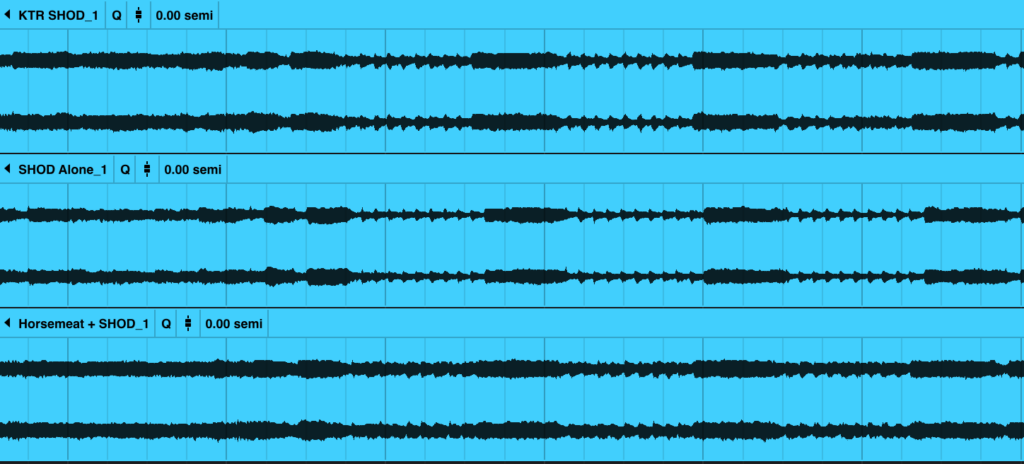
Here’s what you’re looking at:
- At the top is the Klon KTR into the SHOD.
- In the middle is the SHOT on its own.
- At the bottom is the Horsemeat into the SHOD.
As the waveforms clearly show, the Horsemeat brings a lot of compression to the signal.
I’m not saying that’s a bad thing, just that it’s another way that the Horsemeat is different to a clean-boosting Klon.
And, it has to be said: it’s always possible the compression is happening in the SHOD, because I could be slamming it too hard with the Horsemeat. I don’t think that’s what’s happening, but do keep it in mind, in case I’ve got the source of the compression wrong.
After a quick break for second coffee, I’ve tweaked the Horsemeat settings, just to see if I can dial back that overall compression effect:
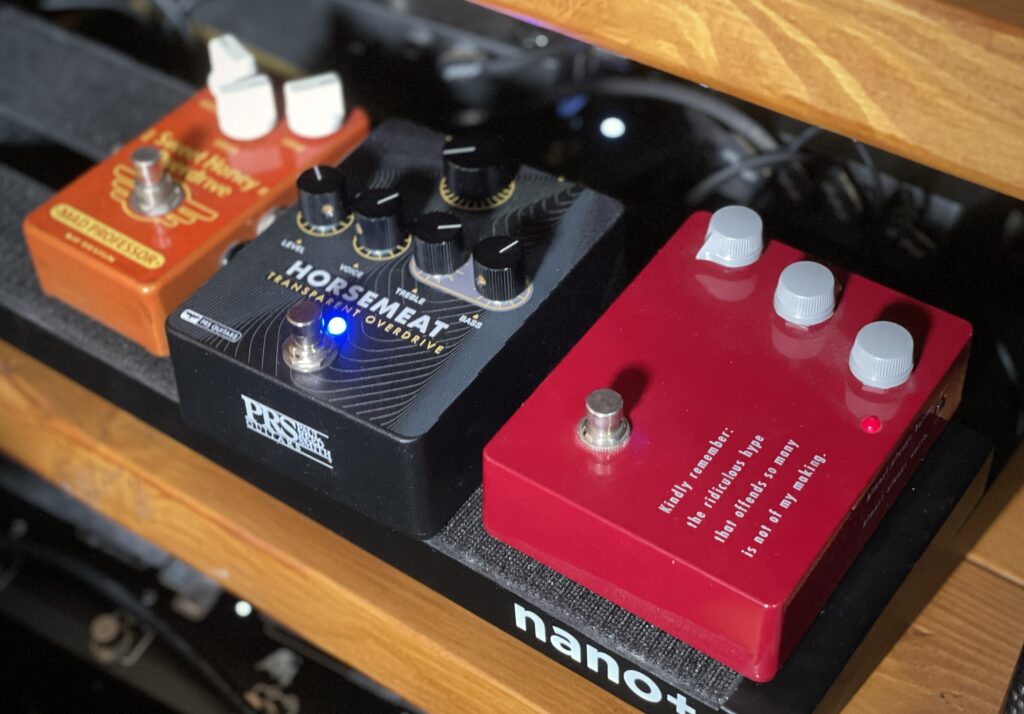
I’ve dialled back the Gain control, dialled up the Voice control, and also boosted the Bass and Treble controls. The end result is a lot better – as in, far less compressed.
Rightly or wrongly, it looks to me that the Gain control on the Horsemeat directly affects the amount of compression that the Horsemeat adds.
These tests have left me in no doubt at all: the PRS Horsemeat isn’t going to replace the Klon KTR on my board, and therefore (for my needs) the Horsemeat isn’t a Klon-killer.
… But It’s A Killer Tweed-Tone Drive Pedal
Even though PRS have marketed the Horsemeat as a Klon killer, they’ve always been clear that it isn’t based on the Klon circuit. And that leads me onto the second – and final – part of today’s #CoffeeAndKlon …
… and the other reason I’ve got the SHOD on my board for this.
Regular readers will be well aware that I am a lover of all things tweed-tone. While these tweed-tone pedals are often quite some distance from the sound of an actual vintage tweed-era Fender amp, they’re the sound that I’ve been looking for all my guitar-playing life.
It turns out that the PRS Horsemeat is an excellent tweed-tone pedal in its own right (whether intentionally or not). It might even be the best-sounding tweed-tone pedal that’s currently in production.
This photo shows how I’m currently dialling in the Horsemeat to get me a tone that’s very similar to my beloved SHOW.
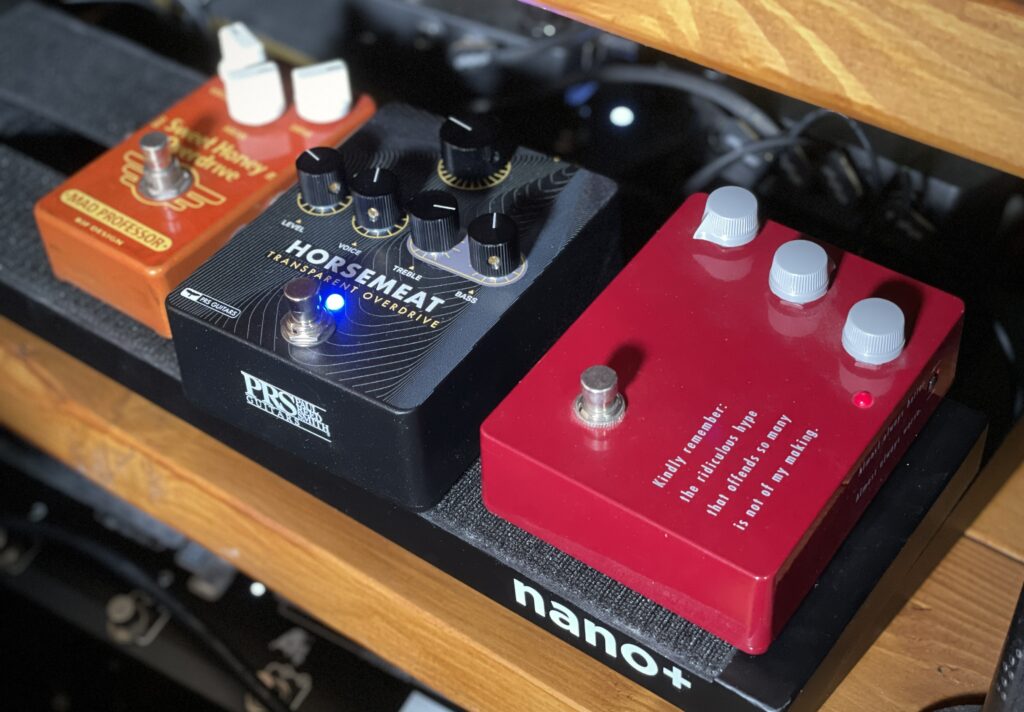
It isn’t the same as the SHOD:
- it’s a thicker sound,
- it doesn’t have quite-as-prominent upper mids
- it’s a lot more compressed
Stick a Klon in front of it, and this is what it sounds like. It sounds glorious.
Which Is Your Favourite As The Primary Overdrive Pedal?
I’ve spent the last two months (October and November 2022) feeling that the Horsemeat was my new #1 overdrive pedal. Now, I’m not so sure, at least not with my Les Paul.
I’ve just grabbed my Telecaster (humbucker in the neck, Nocaster-type single coil in the bridge) to see if my opinion changes. And no, it’s no good, right now, my ears are definitely in the mood for my beloved SHOD.
The Horsemeat sounds great too – and the EQ controls make it a lot more flexible than the SHOD is, for sure.
[Update: the morning after the live-posting on Mastodon, with fresh ears, I found myself preferring the Horsemeat once again. The Horsemeat sounds a little less vintage, and therefore it can be just an easier sound to listen to.]
What About As A Cranked Boost?
I’m not going to test the PRS Horsemeat as a cranked boost into a cranked amp today.
Why? It’s simply not what I use my Klon for.
It’s not my world, and I don’t know enough about it to say anything really about using either the Klon KTR or the Horsemeat that way. I’m sure you can find plenty of folks on YouTube who have done this, and who can talk about it with confidence and experience.
What About As A Tone-Shaping Tool?
Regular readers may recall that I often use a Klon (normally the Wampler Tumnus Deluxe) as a tone-shaping tool … or perhaps it’s better to say as a tone-rescuing tool.
I haven’t tried this yet.
I’ll keep it in mind, and give it a go the next time I’m trying to fix a tone from another pedal.
Final Thoughts
The PRS Horsemeat is not a Klon-killer for me. It’s not going to kick my Klon KTR off my board. Maybe there’s a setting I haven’t discovered that’ll suddenly provide the mid-boost that is missing? I can’t rule that out. But after 3 months now with the pedal, I still haven’t found such a setting by myself.
It is a great sounding tweed-tone pedal – right up there with my beloved SHOD. It gives me another option when I want tweed tone, and I love having options. As far as I’m concerned, I now have three #1 drive pedals: the SHOD, the Horsemeat, and the Brantone Electronics Vintage Overdrive. I’m very happy with that.
Is the PRS Horsemeat worth the money? For me it is, because I’m totally gaga for tweed-tone. The EQ controls make this a very flexible / adaptable pedal, and that’s very rare amongst tweed-tone pedals. Most are one-trick ponies!
When I bought it, I wasn’t expecting it to give me tweed tones. I bought it because I was expecting it to be interesting, and I think that it is.
I hope you’ve enjoyed this #CoffeeAndKlon instalment.
